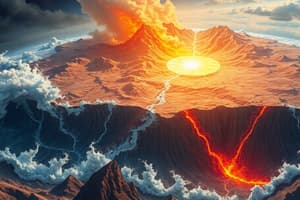Podcast
Questions and Answers
What is the focus of an earthquake?
What is the focus of an earthquake?
- The point on the Earth's surface where the earthquake is felt the most.
- The line along which the tectonic plates slip.
- The distance from the epicenter to the nearest city.
- The location within the Earth where the earthquake originates. (correct)
Tsunamis are always caused by underwater volcanic eruptions.
Tsunamis are always caused by underwater volcanic eruptions.
False (B)
Who proposed the Continental Drift Theory?
Who proposed the Continental Drift Theory?
Alfred Wegener
The outermost layer of the Earth is called the ______.
The outermost layer of the Earth is called the ______.
Match the tectonic waves to their characteristics:
Match the tectonic waves to their characteristics:
What major event did the 2004 Indian Ocean earthquake lead to?
What major event did the 2004 Indian Ocean earthquake lead to?
Continental drift suggests that continents were once all connected as one large landmass.
Continental drift suggests that continents were once all connected as one large landmass.
The hot, semi-liquid rock beneath the Earth's crust is known as ______.
The hot, semi-liquid rock beneath the Earth's crust is known as ______.
Which type of volcano is characterized as unlikely to erupt again?
Which type of volcano is characterized as unlikely to erupt again?
All volcanoes are formed solely at divergent boundaries.
All volcanoes are formed solely at divergent boundaries.
What are the three types of plate boundaries?
What are the three types of plate boundaries?
Magma rises to the surface when it is forced out through __________ tectonic boundaries.
Magma rises to the surface when it is forced out through __________ tectonic boundaries.
Match the following definitions with their correct terms:
Match the following definitions with their correct terms:
What is the primary location where most volcanic activity occurs?
What is the primary location where most volcanic activity occurs?
Dormant volcanoes are currently active and showing signs of eruption.
Dormant volcanoes are currently active and showing signs of eruption.
Explain the difference between divergent and convergent boundaries.
Explain the difference between divergent and convergent boundaries.
Flashcards
Earthquake Cause
Earthquake Cause
Earthquakes are caused by tectonic plates moving past each other, releasing energy as seismic waves.
Epicenter
Epicenter
The point on Earth's surface directly above the earthquake's starting point (focus).
Tsunami Cause
Tsunami Cause
A large wave caused by underwater earthquakes, volcanic eruptions, or other Earth crust movements.
Continental Drift Theory
Continental Drift Theory
Signup and view all the flashcards
Seismic Waves
Seismic Waves
Signup and view all the flashcards
P-waves
P-waves
Signup and view all the flashcards
Earth's Crust
Earth's Crust
Signup and view all the flashcards
2004 Indian Ocean Tsunami
2004 Indian Ocean Tsunami
Signup and view all the flashcards
Oceanic Crust
Oceanic Crust
Signup and view all the flashcards
Plate Boundaries
Plate Boundaries
Signup and view all the flashcards
Divergent Boundaries
Divergent Boundaries
Signup and view all the flashcards
Convergent Boundaries
Convergent Boundaries
Signup and view all the flashcards
Transform Fault Boundaries
Transform Fault Boundaries
Signup and view all the flashcards
Active Volcano
Active Volcano
Signup and view all the flashcards
Dormant Volcano
Dormant Volcano
Signup and view all the flashcards
Extinct Volcano
Extinct Volcano
Signup and view all the flashcards
Study Notes
Earthquakes
- Earthquakes are caused by tectonic plates slipping past each other, releasing energy in seismic waves.
- Epicenter: The point on Earth's surface directly above the earthquake's origin.
- Focus: The location within the Earth where the earthquake originates.
- P waves (Primary waves): Fastest; compress and stretch rocks.
- S waves (Secondary waves): Slower than P waves; move rocks side to side.
- L waves (Surface waves): Most destructive; move in circular or up-and-down motions along the surface.
- Understand the 2004 Indian Ocean and 2011 Tohoku earthquakes and tsunamis: (How, What, Where, When).
Tsunamis
- Tsunamis are large waves caused by underwater earthquakes, volcanic eruptions, or other crustal movements.
- Historical Tsunamis (e.g., the 2004 Southeast Asian tsunami, and 1883 Krakatau eruption).
Plate Tectonics and Continental Drift
- Continental Drift Theory: Continents were once connected in a supercontinent called Pangaea.
- Evidence for Continental Drift includes: similar fossils and mountain ranges found on separated continents; and matching glacial features.
Earth's Structure
- Layers of the Earth: Crust (continental and oceanic), Mantle (magma), Core (outer liquid, inner solid).
- Continental Crust/Oceanic Crust: Continental crust forms land, oceanic crust is found under oceans (is denser).
- Diagram: Study and label the Earth's structure diagram.
Volcanoes
- Volcano location: Primarily at tectonic plate boundaries, especially along the Ring of Fire.
- Volcano types (by activity): Extinct (unlikely to erupt), Dormant (not currently active but may erupt), Active (showing signs of erupting or currently erupting).
- Volcano Formation: Magma forms at boundaries and is forced out, often resulting in eruptions.
Plate Boundaries
- Types of Plate Boundaries:
- Divergent: Plates move apart, creating new crust.
- Convergent: Plates collide, resulting in subduction, mountain formation or volcanic activity.
- Transform: Plates slide past each other without creating or destroying crust.
- Seafloor Spreading: Hot magma rises, creating new crust, pushing continents apart over time.
Study Tips
- Focus on definitions (epicenter, focus, tsunami, continental drift, Ring of Fire).
- Understand Earth's structure diagram (crust, mantle, core).
- Be familiar with historical events (e.g., Southeast Asian tsunami of 2004, Krakatau eruption).
- Know the characteristics of P, S, and L waves (speed and destructiveness).
- Practice labeling diagrams.
Studying That Suits You
Use AI to generate personalized quizzes and flashcards to suit your learning preferences.




